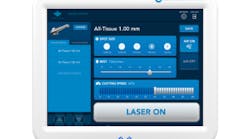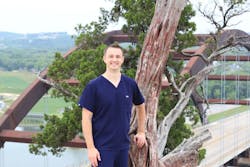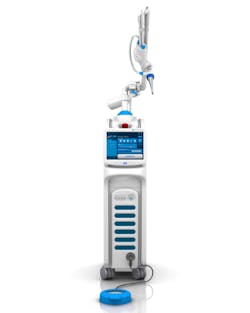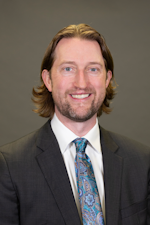Since its introduction in 2013, the Solea CO2 all-tissue laser has made anesthesia-free treatment possible for a number of dental procedures. One specialty that has benefited in particular is pediatric dentistry. In this interview, pediatric dentist Jared Poplin, DMD, discusses his experience using Solea.
Interview with Dr. Jared Poplin
DIQ: Dr. Poplin, can you tell us a little about yourself?
Dr. Poplin: I am a pediatric dentist and the private practice owner of Poplin Pediatric Dentistry located in Austin, Texas. I attended Temple University School of Dentistry and did my pediatric residency at St. Christopher’s Hospital for Children in Philadelphia.
DIQ: What type of dental practice do you have?
Dr. Poplin: My dental practice is focused on pediatric orofacial growth and development. We provide personalized oral health care for every child, and we strive to create a fun yet relaxing environment for children of all ages.
DIQ: What is the philosophy of your practice?
Dr. Poplin: Our goal is to provide exceptional dental care in a warm, child-friendly environment. Our team understands that a child’s early experiences with dental visits can leave a lasting impression on their lifelong oral health, which is why we do our best to provide a comfortable and inviting office setting.
DIQ: What made you decide to explore laser technology?
Dr. Poplin: Our team is committed to staying current with advances in dentistry that make treatment easier and more efficient. There's a lot of new technology to choose from, but we're committed to investing in equipment that streamlines treatment and minimizes discomfort. My goal is to provide my patients with the best dental experience possible while working as efficiently as we can.
Purchasing Solea was one of the smartest decisions made in my practice. To have a technology that can eliminate injections to children for common dental procedures is a game changer. I think that we all know that time is of the essence when dealing with children. To be able to perform any kind of dental treatment as quickly as possible is very important in order to lower the risk of anxiety or fear while the child is at the dentist. Eliminating anesthesia enables significantly less time spent in the chair.
I truly believe that laser dentistry will soon be the standard of care in dentistry.
DIQ: How long have you been using Solea?
Dr. Poplin: I’ve been a Solea user for about three years now.
DIQ: Why did you choose Solea?
Dr. Poplin: I initially looked at another CO2 laser for soft tissue work only. I decided I wanted something that would give my practice a better ROI and also do more. Solea is an all-tissue laser and works beautifully with both hard and soft tissue. I wanted to offer an improved patient experience without anesthesia, which is so essential for children. I envisioned that Solea would change my practice for the better. Never did I imagine that it would actually transform the patient experience to the extent that it has.
DIQ: How does it make the practice of dentistry easier?
Dr. Poplin: Not having to talk children through the process of giving local anesthesia is huge. Just taking the shot out of the equation is a total game-changer. This saves a lot of time and reduces the fear of being at the dentist. It’s less stressful on me, as well, as pediatric dentistry is all about behavior management. It makes my job so much easier!
Basically, the kids that visit me are happier, and their acceptance to care is so much higher. In addition, the parents are more at ease because they see that their children are having stress-free experiences.
DIQ: Have you found yourself performing new procedures in-house that you used to refer out?
Dr. Poplin: I do a lot more esthetic soft tissue work and exposures for orthodontics that I use to have to refer to a periodontist. Some procedures we commonly perform using Solea are gingivectomies, frenectomies, and relief from cold sores and canker sores. I do many more of these soft-tissue procedures now. I did them before Solea, but certainly not as well or as efficiently. Patients are astounded that seemingly major procedures such these are performed and completed easily, quickly, and with minimal post-op pain.
DIQ: What differences have you found that Solea makes in your day-to-day workflow?
Solea makes my chair time shorter and allows me to work more efficiently. I am able to be much more productive. I am able to do more of what I was already doing, including multiquadrant dentistry. I can better utilize my time, and at this point I can’t imagine practicing without it. It provides a phenomenal dental experience to both me and my patients, and has generated practice growth far beyond anything I could have imagined.
DIQ: What differences have you found that Solea makes in your production?
Dr. Poplin: I try not to pack a lot more patients in because I’d rather provide a great quality patient experience and better outcomes over quantity of patients—but it’s tempting because Solea allows me to do both! For example, I normally see about eight operative appointments in one day, and now I can easily do 12 if I want without feeling stressed about time. It is possible to schedule more patients in a day due to not having to wait on anesthetic and the behavior management that it often takes to do that.
We are also able to work in more patients for operative work at their recall appointments. Solea eases the burden of time-consuming procedures and provides me with the freedom of knowing that I can do a certain amount of procedures if I choose to do so. Moreover, patient compliance has increased substantially because of Solea. We now have fewer cancellations than ever before! Our parents and patients no longer fear the shots, pain, and post-op healing time that traditionally came with certain procedures that we now do quickly, efficiently, and without discomfort.
DIQ: What benefits does the laser bring to your patients?
Dr. Poplin: Working with a dental laser, we can now perform many procedures without discomfort and with little or no bleeding after treatment. Not having to leave with a numb face is probably what the patients and their parents appreciate most. Parents also comment on how fast the procedures are, and the time savings because we can easily do multiquadrant dentistry in one appointment. This means less time away from work for parents and shorter and fewer visits for patients.
DIQ: Are your clinical outcomes better?
Dr. Poplin: Yes. For soft tissue work, Solea’s healing is much better than the diode that I used to use. There is zero charring with Solea, less inflammation, and less scar tissue, since it does not produce the heat that a diode laser does. Also, because there is little to no bleeding, I have a clear field of vision that allows me to work more precisely.
Also, Solea allows me to treat teeth and the surrounding areas much more conservatively as well. I am able to remove only the diseased part of the tooth while preserving healthy tooth structure. What’s more, soft-tissue procedures heal so much faster, there is less post-op discomfort, and less need for analgesics.
DIQ: What does it mean to you to be able to take anesthesia out of the equation? What does it mean for your patients?
Dr. Poplin: With Solea, we can fix cavities anesthesia-free. This is huge. I have numbed fewer than ten primary teeth for operative work since I started using Solea three years ago, and am over 95% anesthesia free in permanent teeth. Not having to worry about being numb after the visit and going back to school or going to eat is a big deal for my patients.
DIQ: What has been the feedback from parents?
Dr. Poplin: They love the technology and how fast procedure times are. When a child leaves after a filling and they are smiling like nothing happened. It’s a great feeling!
Parents ask all the time if they can come to our office for their treatment, so I just refer them to a general dentist that has Solea in their practice. Everyone leaves happy, and it’s such a great feeling.
What’s more, happy parents are likely to post a positive comment online or tell their friends about the great experience their child has had with us.
DIQ: Does any particular case stand out where Solea has made a positive and substantial difference?
Dr. Poplin: I had a seven-year-old boy come from about 4–5 hours away for a consult for treatment after he had been treatment-planned to have all eight primary molars treated under general anesthesia. His grandmother found my office online. He was quite nervous, but with Solea and nitrous oxide, all eight teeth were treated at that appointment with zero anesthesia. He left content and they drove back home right afterward.
DIQ: What would you say to those dentists reluctant to get into laser technology in their practice?
Dr. Poplin: It is one of the best things that I could have done for my practice. Solea really is something that you will use every day and on every operative patient. The learning curve was so small with Solea that literally any dentist can become a “laser dentist.” Between being more efficient, doing more procedures daily, performing procedures in-house that you’ve never thought possible, ease of practice, and better clinical outcomes—not to mention the new patients you will get from word of mouth, it makes it more than worth it.
Related:
'Reliably anesthesia-free': An interview with two Solea laser dentists (VIDEO)
Laser dentistry: A patient's perspective on pain-free treatment
Crown lengthening with a CO2 9.3-μm laser [Dental Economics]
Zachary Kulsrud is senior editor of Endeavor Business Media's dental group, which includes Dental Economics, DentistryIQ, Perio-Implant Advisory, and RDH.








